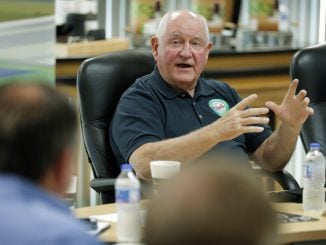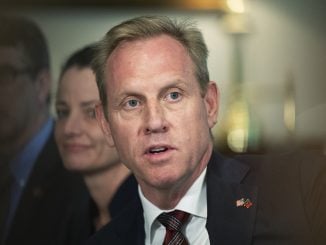
MINNEAPOLIS — President Donald Trump on Wednesday moved to invoke a federal law that allows the government to marshal the private sector to deal with the coronavirus epidemic, as the economic damage mounted with word that Detroit’s Big Three automakers agreed to shut down all their factories to protect workers.
Calling himself a “wartime president,” Trump said he would sign the Defense Production Act “in case we need it” as the government bolsters resources for an expected surge in cases of the virus.
With a growing number of Americans thrown out of work by the near-shutdown of much of the U.S. economy, he also said the Housing and Urban Development Department will suspend foreclosures and evictions from public housing through April.
Two people briefed on the matter said Wednesday that Ford, General Motors and Fiat Chrysler agreed to close all their factories. The two spoke on condition of anonymity because the closings had not been announced. The move would idle about 150,000 workers, who are likely to receive supplemental pay in addition to unemployment benefits.
Meanwhile, across the European continent, desperate travelers choked border crossings after countries began shutting the doors against the coronavirus, which has now infected more than 200,000 people worldwide and killed over 8,000.
And the Trump administration was said to be considering a plan to turn back all people who cross into the United States illegally from Mexico.
Some bright spots emerged: Wuhan, the central Chinese city where the virus was first detected in late December and which has been under lockdown for weeks, reported just one new case for a second straight day Wednesday.
But in a grim illustration of the epidemic’s shifting center of gravity, the death toll in Italy moved closer to overtaking China’s. Italy had more than 2,500 dead and was averaging about 350 a day; China’s toll was just over 3,200.
Meanwhile, the United Nations’ International Labor Organization estimated that the crisis could cause nearly 25 million job losses and drain up to $3.4 trillion in income by year’s end, but that a coordinated global response in the form of fiscal stimulus and other measures could help reduce the toll.
In releasing the new global infection figures, Johns Hopkins University said more than 82,000 people have recovered from the virus, which causes only mild or moderate symptoms such as fever and cough in most cases, though severe illness is more likely in the elderly and those with existing health problems.
Still, scientists have no doubt the true number of people infected is higher than the 200,000 reported by health authorities because of the possibility that many mild cases have gone unrecognized or unreported, and because of the lag in large-scale testing in the U.S.
The U.S. reported more than 6,500 cases and at least 116 deaths, almost half of them in Washington state, where dozens of residents from a suburban Seattle nursing home have died.
In the first-ever breakdown of its kind in the U.S., the Centers for Disease Control and Prevention reported that coronavirus deaths in the United States mirror what has been reported in other countries, with about 4 out of 5 deaths occurring in people 65 and older — and no deaths in children.
The coronavirus is present in all 50 states after West Virginia reported an infection. In Hawaii, the governor encouraged travelers to postpone their island vacations, while Nevada ordered its casinos closed.
New York City Mayor Bill de Blasio warned that residents should be prepared for the possibility of a shelter-in-place order within days — a near-lockdown like the one covering almost 7 million people in the San Francisco Bay area. In the most sweeping measure of its kind in the U.S., they are allowed to leave their homes only for food, medicine or exercise.
The Trump administration’s plan for issuing relief checks to Americans calls for the payment of $500 billion in two installments, in April and May. The amounts have yet to be decided but would be based on income and family size.



